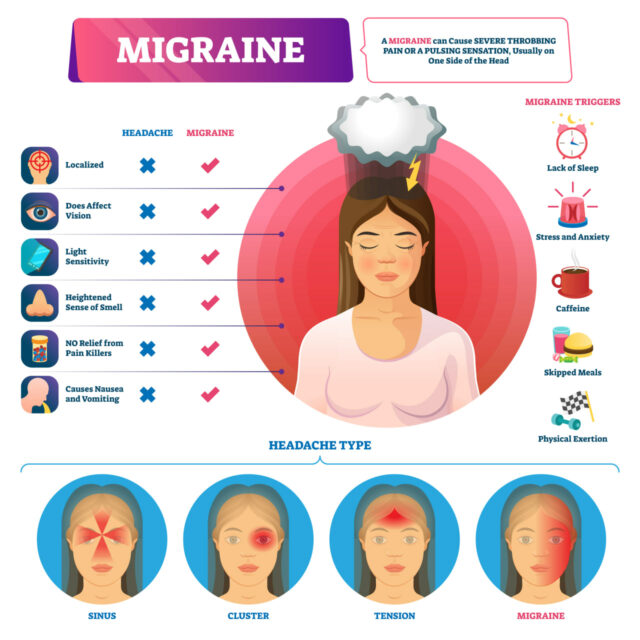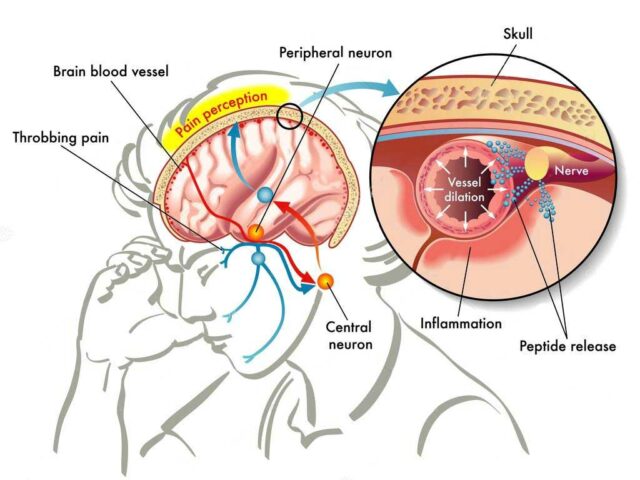Fibromyalgia

Understanding The Relationship Between Fibromyalgia And Migraines
Read More
October 12, 2023
Today, it is estimated that over 12% of the population suffers from migraines, and a large percentage is affected by chronic episodes. Understanding the stages of migraine headaches is crucial, as these can have a profound impact on your mental health, physical well-being, productivity, and overall quality of life.
That’s why, whether you are plagued by chronic headaches or looking to help a loved one diagnosed with migraines, it is vital to understand how this condition manifests itself.
Migraines differ from other forms of pain in the head in the fact that they are classified as a neurological disorder, which derives from changes in the brain’s chemical reactions and pathways. Also, unlike other types of headaches, migraines occur in four distinct stages:
A lot about migraines isn’t yet well understood. However, educating yourself about the types and stages of migraines can help you improve your quality of life and even stop an attack as it begins to develop. Let’s cover these important topics in the sections below.
The prodrome – also known as “pre-headache” – is often the first phase of a migraine. This premonitory phase is characterized by a range of symptoms and signs, which are usually related to visual changes, mood swings, and dysfunction of systems such as digestion.
The prodrome phase usually develops within hours or days after you are exposed to a trigger. This phase indicates that a full-scale migraine attack is coming. However, there is a lot that you can do to halt the migraine as it develops, especially during this early stage.
Some key takeaways include:
You should also learn to recognize the difference between prodrome symptoms and the signs of an aura. While these two experiences can overlap, they have distinct symptoms and durations. Learn more below.
As we have seen, premonitory symptoms can change significantly from one person to another. Common ones include:
Usually, prodrome symptoms start between three days and 24 hours before a migraine, and the abnormal sensations can last for hours or days at a time.
No two people suffering from migraines will have exactly the same experience. And premonitory signs can vary, too.

Usually, migraines are divided into three categories:
Around a third of people with migraines will experience at least one premonitory sign. These can be abnormal sensations, impaired speech, unexplained mood changes, or visual and motor disturbances.
Although the causes of aura are not clear, research links these symptoms to abnormal electrical activity in the brain. Below, we’ll look at the distinctive signs and duration of aura.
The aura phase is different from one person to another. However, learning to recognize the symptoms you tend to experience can help you go to a dark room or to rest, which may decrease the intensity of the upcoming headache.
These symptoms include:
Other symptoms can also develop. For example, some people experience sensations of being touched, ringing in the ears, or feeling like they are looking at objects through water.
The neurological symptoms of an aura tend to develop in the 24 hours before the headache. In most cases, symptoms intensify shortly before the migraine attack, usually within 10 – 60 minutes.
The headache is the main phase of a migraine attack. During this stage, you are likely to experience severe throbbing pain, sensitivity to lights and sounds, sleep disturbances, and problems like nausea and vomiting.
The pain can be so intense that it prevents you from being able to work or concentrate, and it can force you to lie in a dark, quiet room for hours at a time.
Understanding what symptoms characterize your migraine can help you find a line of treatment that can help ease your symptoms. These are “rescue” treatments that won’t help treat the root cause of migraines but can ease symptoms during flare-ups.
Each migraine attack varies in intensity and nature. Some of the most common symptoms you may experience include are:
Migraine pain derives from abnormal waves of activity among excitable brain cells. These cells signal chemicals (such as serotonin and estrogen) to narrow blood vessels and nerve endings, which causes throbbing pain.

These symptoms are often a consequence of the pain, nausea, sleep deprivation, and hypersensitivity you experience during a migraine.
Other symptoms that may occur during a migraine attack include:
A migraine attack can last from several hours to a few days. In particular, the most intense symptoms last around four hours. However, if left unaddressed, pain, vomiting, dizziness, and hypersensitivity can last up to 72 hours.
The postdrome phase – also known as “migraine hangover” – occurs after the headache and pain have subsided. During this stage, you’ll experience muscle weakness, feel tired or confused, and suffer pain and discomfort anywhere in the body.
Although this stage signals the end of a migraine attack, it can increase your recovery time or delay your return to work. To reduce the syndrome of postdrome, follow best practices such as:
Postdrome symptoms include:
The timeline and duration of a migraine attack can vary from one person to another. However, studies have shown that postdrome symptoms occur in around 88% of cases and last an average of 24 hours. Some residual symptoms – such as weakness and confusion – can linger for up to 48 hours after the headache.
While migraines are not necessarily life-threatening, they can profoundly impact your life. Those battling this condition miss an average of 4.4 days of work per year and have a further 11 days of reduced productivity. Increased medical costs, lack of sleep, and excessive stress can also contribute to declining mental and cognitive health.
To make things worse is the fact that episodic migraines, which occur less than 15 times a month, can become chronic and cause people to deal with over 15 days of headache a month. In this case, seeking adequate treatment can help your condition regress into episodic headaches, which are milder, less disruptive, and easier to manage.
You should also seek immediate medical care if, at any stage of your migraine episode, you experience symptoms such as numbness, vision loss, shortness of breath, chest pain, nosebleeds, high fever, or slurred speech. These symptoms can indicate another underlying and potentially life-threatening condition, such as a stroke.
The signs that you should see a doctor without delay include:
Migraines can interfere with your personal and professional lives. To make things worse is also the fact that doctors may recommend treatments that do very little to treat the root cause of your disease, while exposing you to unnecessary side effects.
Fortunately, there’s another path to regaining your health. The Neurofunctional Pain Management protocol pioneered by Relatyv can help you tackle the systemic inflammation at the root of most migraine attacks – without medications or surgery.
Through electroanalgesia, IV therapy, and lifestyle counseling, you can also better manage your stress levels, improve your sleep quality, and fine-tune your environment to reduce sensitivity to triggers.
About the Author
Will is a healthcare executive, innovator, entrepreneur, inventor, and writer with a wide range of experience in the medical field. Will has multiple degrees in a wide range of subjects that give depth to his capability as an entrepreneur and capacity to operate as an innovative healthcare executive.
Share on Social Media




You can see how this popup was set up in our step-by-step guide: https://wppopupmaker.com/guides/auto-opening-announcement-popups/
You can see how this popup was set up in our step-by-step guide: https://wppopupmaker.com/guides/auto-opening-announcement-popups/
Neurofunctional Pain Management Overview
Symptoms
Conditions Treated
Treatments
Articles by Category
Locations
Colorado
Wisconsin
Georgia
Hiram
Lawrenceville
Marietta
Powder Springs
Texas
Waco
Victoria
Illinois
Buffalo Grove
New Lenox
St. Charles
Arizona
Tucson
Waddell
Arlington
Avondale
Buckeye
Superior
Mesa
Palo Verde
Morristown
Tempe
Chandler
Anthem
Eloy
Florence
Fort McDowell
Phoenix
El Mirage
Coolidge
Gilbert
Arizona City
Casa Grande
Casa Blanca
Aguila
Sacaton
Apache Junction
Kearny
Stanfield
Goodyear
Litchfield Park
Alabama
Arkansas
California
Florida
Idaho
Indiana
Iowa
Kansas
Louisiana
Maryland
Michigan
Rhode Island
Minnesota
Mississippi
Nevada
New Jersey
New Mexico
North Carolina
Ohio
Pennsylvania
South Dakota
Tennessee
Utah
Virginia
Washington

